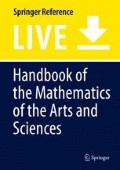Abstract
Complex geometrical designs are a familiar feature of Islamic art. Here we consider the historical context of this genre, tracing it back to the influence of the Platonism and Hellenistic Neo-Platonism that Islam encountered in its early conquest of Byzantine territories (in particular the enormous contribution of Euclid).
In addition, the modern analysis is presented showing the relationship in mathematical terms. Such an analysis naturally leads to the presentation of the patterns using computer graphics.
David Wade is the primary author of sections 1–8, and Brian Wichmann for sections 9–10.
References
Al-Khalili J (2010) Pathfinders. Allen Lane, New York
Allen T (2004) Islamic art and the argument from academic geometry. Solipsist Press, Weidenfield & Nicholson
Al-Naqsh MM (1983) Design and execution of drawing in Iranian tilework, Islamic period. Reza Abbasi Museum, (In Persian)
Blair SS (2006) Islamic calligraphy. Edinburgh University Press, Edinburgh
Bloom JM (2001) Paper before print: the history and impact of paper in the Islamic world. Yale University Press, New Haven
Bloom JM (2007) Arts of the city victorious. Yale, New Haven
Bonner J (2016) Islamic geometric patterns. Springer. ISBN:9781441902160
Bourgoin J (1873) Les arts arabes. Morel, Paris
Bourgoin J (1879) Les Eléments de l’art arabe: le trait des entrelacs, Paris (Patterns available as a Dover reprint)
Broug E (2008) Islamic geometric patterns. Thames & Hudson, London
Broug E (2013) Islamic geometric design. Thames and Hudson, London
Castéra J-M (1999) Arabesques: decorative art in Morocco. ACR Edition, Paris
Chorbachi WK (1989) In the tower of babel: beyond symmetry in Islamic design. Comput Math Appl 17(4–6):751–789
De Boer TJ (1903) The history of philosophy in Islam. Luzac, London
Du Sautoy M (2008) Finding moonshine—a mathematician’s journey through symmetry. Fourth Estate, London. ISBN:978-0-00-721467-2
Freely J (2009) Aladdin’s lamp: how Greek science came to Europe through the Islamic world. Alfred A. Knoopf, New York
Grabar O (1973) The formation of Islamic art. Yale University Press, New Haven
Grünbaum B (2006) What groups are present in the Alhambra? Not Am Math Soc 53:670–673. http://www.ams.org/notices/200606/comm-grunbaum.pdf
Grünbaum B, Shephard GC (1987) Tilings and patterns. W. H. Freeman & Co., New York
Jagy W (2000) What Islamic tiling patterns are constructible? http://mathoverflow.net/questions/35526
Jaworski J (2006) A mathematician’s guide to the alhambra. Available on the Internet via http://www.grout.demon.co.uk/Travel/travel.htm
Jones O (1856) The grammar of ornament. Dover. (reprint) Original version available on the Internet
Jones O, Goury J (1837) Plans, elevations, sections, and details of the Alhambra…. O. Jones, London
Kennedy H (2005) When Baghdad ruled the Muslim world. Da Capo Press, Cambridge
Khaldun I (1967) In: Dawood NA (ed) The Muqaddimah: an introduction to history (trans: Franz Rosenthal). Princeton University Press, Princeton, Routledge and Kegan Paul
Kühnel E (1949) Arabesques. Verlag für Sammler
Lee AJ (1987) Islamic star patterns. Muqarnas 4:182–197
Lee T, Soliman A (2014) The geometric rosette: analysis of an Islamic decorative motif. http://www.tilingsearch.org
Montesinos JM (1985) Classical tessellations and three-manifolds. Springer. ISBN:3-540-15291-1
Montgomery Watt W (1972) The influence of Islam on medieval Europe. Edinburgh University Press, Edinburgh
Morewedge P (ed) (1992) Neoplatonism and Islamic thought. University of New York, Albany
Müller E (1944) Gruppentheoretische und Strukturanalytische Untersuchungen der Maurischen Ornamente aus der Alhambra in Granada. PhD thesis, Zürich University. Baublatt, Rüschlikon
Necipoğlu G (1995) The Topkapı scroll: geometry and ornament in Islamic architecture. The Getty Center for the History of Art and the Humanities, Santa Monica
Özdural A (2000) Mathematics and arts: connections between theory and practice in the medieval Islamic world. Hist Math 27:171–201
Paccard A (1980) Traditional Islamic craft in Moroccan architecture. Saint-Jorioz, Atelier
Routledge, Kegan P (1975) The classical heritage in Islam. University of California Press, Berkeley
Saliba G (2011) Islamic science and the making of the European renaissance. MIT Press, Cambridge
Tiling search web site (2019) www.tilingsearch.org. Graphics refer to a specific web site URL, e.g., data162/P077 gives the www.tilingsearch.org/HTML/data162/P077.html
Wade D (2018) Patterns in Islamic art. The web site: www.patterninislamicart.com. Photos reference in the format EGY 0512
Wichmann BA (2001) The world of patterns. World Scientific. ISBN:981024619
Wichmann B, Rigby J (2009) Yemeni squares. MIT Press, Leonardo 42(2):156–162
Wichmann B, Wade D (2017) Islamic design: a mathematical approach. Birkhäuser, Cham
Author information
Authors and Affiliations
Corresponding author
Editor information
Editors and Affiliations
Section Editor information
Rights and permissions
Copyright information
© 2019 Springer Nature Switzerland AG
About this entry
Cite this entry
Wichmann, B., Wade, D. (2019). Islamic Design and Its Relation to Mathematics. In: Sriraman, B. (eds) Handbook of the Mathematics of the Arts and Sciences. Springer, Cham. https://doi.org/10.1007/978-3-319-70658-0_91-1
Download citation
DOI: https://doi.org/10.1007/978-3-319-70658-0_91-1
Published:
Publisher Name: Springer, Cham
Print ISBN: 978-3-319-70658-0
Online ISBN: 978-3-319-70658-0
eBook Packages: Springer Reference MathematicsReference Module Computer Science and Engineering

